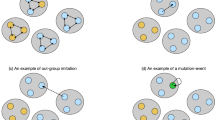Summary
We use Hamilton's Rule to investigate effects of genetic relatedness on the predicted size of social groups. We assume an aggregation economy; individual fitness initially increases with group size, but in sufficiently large groups each member's individual fitness declines with further increments in the size of the group. We model two processes of group formation, designated free entry and group-controlled entry. The first model assumes that solitary individuals decide to join groups or remain alone; group size equilibrates when solitaries no longer choose to join. The second model allows group members to regulate the size of the group, so that the predicted group size results from members' decisions to repel or accept intruding solitaries. Both the Nash equilibrium group size and any change in the equilibrium caused by varying the level of relatedness depend on the particular entry rule assumed. The largest equilibrium group size occurs when solitaries choose between joining or not joining and individuals are unrelated. Increasing genetic relatedness may reduce and can never increase, equilibrium group size when this entry rule applies. The smallest equilibrium group size occurs when group members choose between repelling or accepting intruders and individuals are unrelated. Under this entry rule, increasing genetic relatedness can increase and can never decrease, equilibrium group size. We extend the models' predictions to suggest when individuals should prefer kin vs non-kin as members of the same group.
Similar content being viewed by others
References
Blaustein, A.R., Bekoff, M., Byers, J.A. and Daniels, T.J. (1991) Kin recognition in vertebrates: what do we really know about adaptive value?Anim. Behav. 41, 1079–83.
Caraco, T. and Wolf, L.L. (1975) Ecological determinants of group sizes of foraging lions.Am. Nat. 109, 343–52.
Clark, C.W. and Mangel, M. (1984) Foraging and flocking strategies: information in an uncertain environment.Am. Nat. 123, 626–41.
Clark, C.W. and Mangel, M. (1986) The evolutionary advantages of group foraging.Theor. Pop. Biol. 30, 45–75.
Giraldeau, L.-A. (1988) The stable group and the determinants of foraging group size. InThe Ecology of Social Behavior (C.N. Slobodchikoff, ed.), pp 33–53. Academic Press, NY, USA.
Giraldeau, L.-A. and Gillis, D. (1985) Optimal group size can be stable: a reply to Sibly.Anim. Behav. 33, 666–7.
Giraldeau, L.-A. and Gillis, D. (1988) Do lions hunt in group sizes that maximize hunters' daily food returns?Anim. Behav. 36, 611–3.
Grafen, A. (1982) How not to measure inclusive fitness.Nature 298, 425–6.
Grafen A. (1986) Natural selection, kin selection and group selection. InBehavioural Ecology: An Evolutionary Approach (J.R. Krebs and N.B. Davies, eds), 2nd edn, pp. 62–84. Blackwell, Oxford, UK.
Grafen, A. (1991) Modelling in behavioural ecology. InBehavioural Ecology: An Evolutionary Approach (J.R. Krebs and N.B. Davies, eds), 3rd edn, pp. 5–31. Blackwell, Oxford, UK.
Higashi, M. and Yanamura, N. (1993) What determines the animal group size: insider—outsider conflict and its resolution.Am. Nat., (in press).
Jansson, C.H. (1985) Aggressive competition and individual food consumption in wild brown capuchin monkeys (Cebus appella).Behav. Ecol. Sociobiol. 18, 125–38.
Noonan, K.M. (1981) Individual strategies of inclusive-fitness-maximizing inPolistes fuscatus foundresses. InNatural Selection and Social Behavior: Recent Research and New Theory (R.D. Alexander and D.W. Tinkle, eds), pp. 18–44. Chiron Press, NY, USA.
Pulliam, H.R. and Caraco, T. (1984) Living in groups: is there an optimal group size? InBehavioural Ecology: An Evolutionary Approach (J.R. Krebs and N.B. Davies, eds), 3rd edn, pp. 122–47. Blackwell, Oxford, UK.
Rodman, P.S. (1981) Inclusive fitness and group size with a reconsideration of group sizes in lions and wolves.Am. Nat. 118, 275–83.
Sibly, R.M. (1983) Optimal group size is unstable.Anim. Behav. 31, 947–8.
Smith, E.A. (1981) The application of optimal foraging theory to the analysis of hunter—gatherer group size. InHunter—Gatherer Foraging Strategies (B. Winterhalder and E.A. Smith eds), pp. 36–65. Chicago University Press, Chicago, USA.
Smith, E.A. (1985) Inuit foraging groups: some simple models incorporating conflicts of interest, relatedness, and central-place sharing.Ethol. Sociobiol. 6, 27–47.
Vehrencamp, S.L. (1983) A model for the evolution of despotic versus egalitarian societies.Anim. Behav. 31, 667–82.
Author information
Authors and Affiliations
Rights and permissions
About this article
Cite this article
Giraldeau, LA., Caraco, T. Genetic relatedness and group size in an aggregation economy. Evol Ecol 7, 429–438 (1993). https://doi.org/10.1007/BF01237874
Issue Date:
DOI: https://doi.org/10.1007/BF01237874




